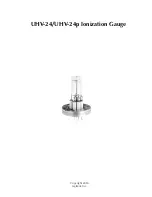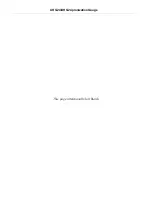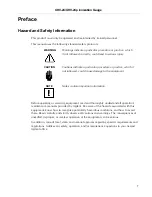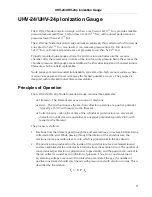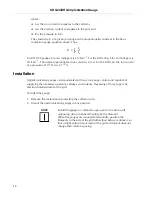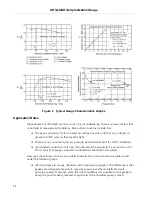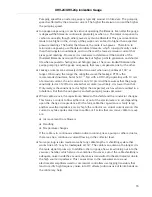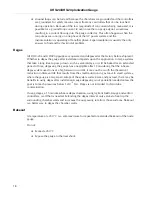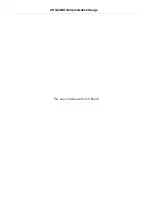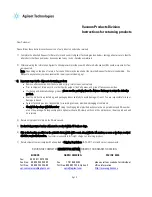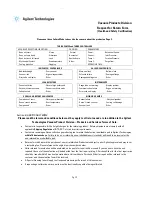
UHV-24/UHV-24p Ionization Gauge
14
DRAF
T
Figure 2 Typical Gauge Characteristics Graphs
Application Notes
Measurement of ultra-high vacuum is not a trivial undertaking. There are many factors that
contribute to measurement problems. Some other concerns include that:
❑
The gauge sensitivity factor is based on nitrogen and very little, if any, nitrogen is
present in UHV systems that are leak tight
❑
There are no convenient primary pressure standards that exist for UHV calibration.
❑
A grounded conductive wall near the tube raises the sensitivity by as much as 30%.
This is typical of gauges mounted in tubulations attached to the system.
However, these three concerns are usually theoretical in nature and most problems fall
under the following areas:
❑
All ion gauges are pumps, (likewise, all ion pumps are gauges). The difference is that
gauges are designed primarily to measure pressure and have relatively small
pumping speeds. However, given the right conditions it is possible for the gauge to
pump the gas that being measured, especially if the chamber pump is small.
Summary of Contents for UHV-24
Page 2: ...D R A F T 1 6 1 4 Copyright 2014 Agilent Inc UHV 24 UHV 24p Ionization Gauge...
Page 4: ...UHV 24 UHV 24p Ionization Gauge This page intentionally left blank D R A F T 1 6 1 4...
Page 6: ...UHV 24 UHV 24p Ionization Gauge This page intentionally left blank D R A F T...
Page 10: ...UHV 24 UHV 24p Ionization Gauge This page intentionally left blank...
Page 20: ...UHV 24 UHV 24p Ionization Gauge 20 D R A F T Table 2 Gas Correction Factor Table...
Page 21: ...UHV 24 UHV 24p Ionization Gauge D R A F T 21 Table B 0 Gas Correction Factor Table Continued...
Page 22: ...UHV 24 UHV 24p Ionization Gauge This page intentionally left blank D R A F T...
Page 26: ...UHV 24 UHV 24p Ionization Gauge This page intentionally left blank...
Page 27: ......


